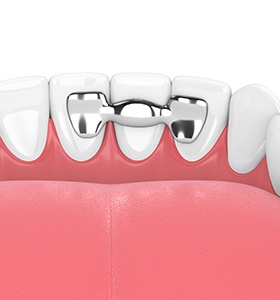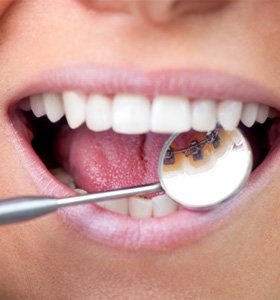
Lingual Braces – Jacksonville, FL
Your Hidden Orthodontic Solution
 Actual Patient
Actual PatientStraightening the teeth can improve how the smile looks and how the mouth functions. This kind of treatment can even lower a person’s risk for cavities, so why do so many people avoid doing it? In one word: braces. People simply don’t want to deal with the look of metal braces on their teeth, even if the treatment itself would be tremendously beneficial. But what if you could get braces that virtually no one would see? That’s exactly how lingual braces work, and Dr. Holland can use them to take your smile to the next level without anyone noticing your treatment.
Why Choose Ortega Orthodontics for Lingual Braces?
- Orthodontic care designed to be completely invisible
- Fourth-generation orthodontist with years of experience
- Able to treat children & adults alike
How Do Lingual Braces Work?

Lingual braces actually work the exact same way as traditional braces, in that a system of brackets and wires is used to slowly move the teeth into the proper alignment. The big difference, however, is that instead of being placed on the front of the teeth, the brackets are placed on the back. This basically means they are hidden from plain view, allowing a patient to maintain their normal day-to-day appearance while improving their smile.
What Kinds of Problems Can Lingual Braces Fix?

Dr. Holland can use lingual braces to fix all of the following issues without your friends or coworkers noticing your treatment:
- Crooked teeth
- Crowded teeth
- Gapped teeth
- Rotated teeth
- Overbite
- Underbite
- Crossbite
How Do I Get Lingual Braces?

If you think lingual braces would be the perfect solution for either yourself or your child, then we invite you to schedule a consultation here at Ortega Orthodontics. At this appointment, Dr. Holland will perform a quick exam, go over all of your treatment options, and let you know if lingual braces would be a good fit. If they are, he can get right to work designing your treatment.
Now, you can get the smile you’ve always wanted in the most discreet way possible! To learn more and schedule a consultation, contact us today.
Lingual Braces FAQs

If you are interested in getting lingual braces, Dr. Holland and our team would be pleased to answer all of your questions during your orthodontic consultation. In the meantime, you may want to do a little reading on your own to prepare for the road ahead. Below, you will find some answers to relevant FAQs about lingual braces. If your specific questions are not addressed here, give us a call so we can personally assist you.
Are Children Candidates for Lingual Braces?
Candidacy for lingual braces is determined on a case-by-case basis. Usually, they are not a great option for young children simply because these patients may not have enough dentition protruding above the gumline for us to securely attach orthodontic brackets. In most cases, teenagers and adults are the best candidates for lingual braces.
How Much Do Lingual Braces Cost?
Just like any other form of orthodontic treatment, the cost of lingual braces varies according to a number of factors. Our team will be happy to provide a cost estimate during your consultation.
Often, lingual braces cost a bit more than traditional, outward-facing metal braces. That is simply because placing lingual braces requires more training, time, and effort, which, of course, leads to higher costs.
If you are concerned about the cost of lingual braces, ask our team about convenient financing options. With the help of available provisions, this treatment fits within most people’s budgets.
Do Lingual Braces Hurt?
All orthodontic treatments cause some degree of discomfort. That is because they work by applying pressure to the teeth, which leads to soreness and tenderness. Typically, this type of discomfort wears off within a few days after braces are placed or adjusted. In the meantime, mild pain relievers, a soft diet, and other reasonable measures can help to take the edge off of any discomfort.
Lingual braces might also cause some mild tongue irritation. Again, this issue is usually temporary and may wear off within a few days.
If your braces ever cause severe or unusual pain, you should contact our team right away for assistance.
Will Lingual Braces Affect My Speech?
Some patients develop a slight lisp after receiving lingual braces. That can occur because your tongue is not used to the brackets on your teeth! Usually, the lisp is very slight. In fact, you may notice it much more than anyone who speaks with you. It also tends to wear off within a few days. Careful, slow speech and lots of practice can help you learn to communicate clearly and confidently while you are wearing braces.